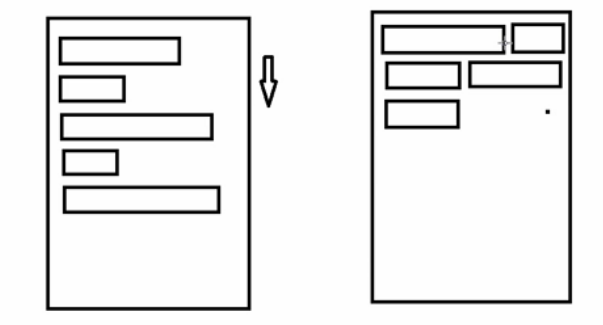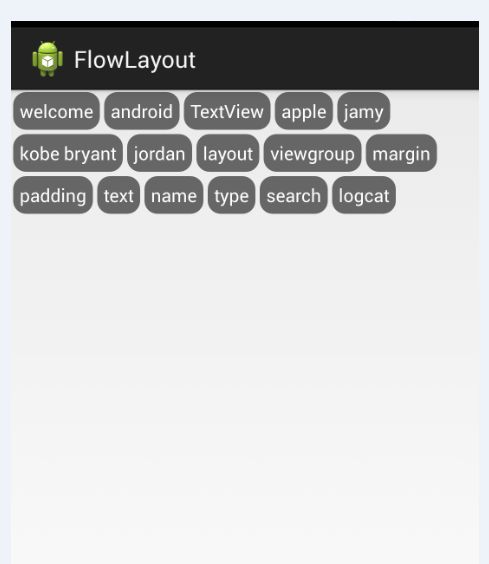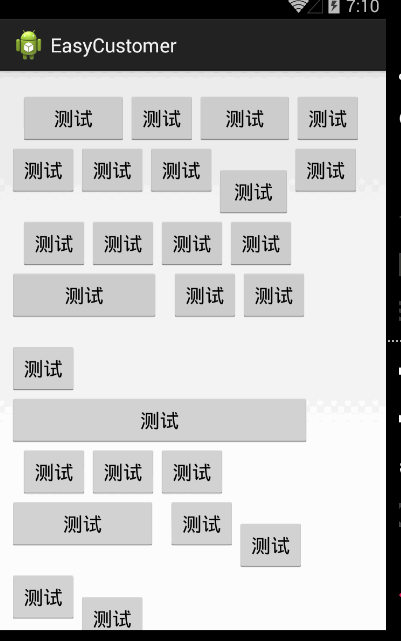Android中常见的热门标签的流式布局的实现
一、概述:
在日常的app使用中,我们会在android 的app中看见 热门标签等自动换行的流式布局,今天,我们就来看看如何
自定义一个类似热门标签那样的流式布局吧(源码下载在下面最后给出)
类似的自定义布局。下面我们就来详细介绍流式布局的应用特点以及用的的技术点:
1.流式布局的特点以及应用场景
特点:当上面一行的空间不够容纳新的TextView时候,
才开辟下一行的空间
原理图:
场景:主要用于关键词搜索或者热门标签等场景
2.自定义ViewGroup,重点重写下面两个方法
1、onMeasure:测量子view的宽高,设置自己的宽和高
2、onLayout:设置子view的位置
onMeasure:根据子view的布局文件中属性,来为子view设置测量模式和测量值
测量=测量模式+测量值;
测量模式有3种:
EXACTLY:表示设置了精确的值,一般当childView设置其宽、高为精确值、match_parent时,ViewGroup会将其设置为EXACTLY;
AT_MOST:表示子布局被限制在一个最大值内,一般当childView设置其宽、高为wrap_content时,ViewGroup会将其设置为AT_MOST;
UNSPECIFIED:表示子布局想要多大就多大,一般出现在AadapterView的item的heightMode中、ScrollView的childView的heightMode中;此种模式比较少见。
3.LayoutParams
ViewGroup LayoutParams :每个 ViewGroup 对应一个 LayoutParams; 即 ViewGroup -> LayoutParams
getLayoutParams 不知道转为哪个对应的LayoutParams ,其实很简单,就是如下:
子View.getLayoutParams 得到的LayoutParams对应的就是 子View所在的父控件的LayoutParams;
例如,LinearLayout 里面的子view.getLayoutParams ->LinearLayout.LayoutParams
所以 咱们的FlowLayout 也需要一个LayoutParams,由于上面的效果图是子View的 margin,
所以应该使用MarginLayoutParams。即FlowLayout->MarginLayoutParams
4.最后来看看实现的最终效果图:
二、热门标签的流式布局的实现:
1. 自定义热门标签的ViewGroup实现
根据上面的技术分析,自定义类继承于ViewGroup,并重写 onMeasure和onLayout等方法。具体实现代码如下:
- package com.czm.flowlayout;
- import java.util.ArrayList;
- import java.util.List;
- import android.content.Context;
- import android.util.AttributeSet;
- import android.view.View;
- import android.view.ViewGroup;
- /**
- *
- * @author caizhiming
- * @created on 2015-4-13
- */
- public class XCFlowLayout extends ViewGroup{
- //存储所有子View
- private List<List<View>> mAllChildViews = new ArrayList<>();
- //每一行的高度
- private List<Integer> mLineHeight = new ArrayList<>();
- public XCFlowLayout(Context context) {
- this(context, null);
- // TODO Auto-generated constructor stub
- }
- public XCFlowLayout(Context context, AttributeSet attrs) {
- this(context, attrs, 0);
- // TODO Auto-generated constructor stub
- }
- public XCFlowLayout(Context context, AttributeSet attrs, int defStyle) {
- super(context, attrs, defStyle);
- // TODO Auto-generated constructor stub
- }
- @Override
- protected void onMeasure(int widthMeasureSpec, int heightMeasureSpec) {
- // TODO Auto-generated method stub
- //父控件传进来的宽度和高度以及对应的测量模式
- int sizeWidth = MeasureSpec.getSize(widthMeasureSpec);
- int modeWidth = MeasureSpec.getMode(widthMeasureSpec);
- int sizeHeight = MeasureSpec.getSize(heightMeasureSpec);
- int modeHeight = MeasureSpec.getMode(heightMeasureSpec);
- //如果当前ViewGroup的宽高为wrap_content的情况
- int width = 0;//自己测量的 宽度
- int height = 0;//自己测量的高度
- //记录每一行的宽度和高度
- int lineWidth = 0;
- int lineHeight = 0;
- //获取子view的个数
- int childCount = getChildCount();
- for(int i = 0;i < childCount; i ++){
- View child = getChildAt(i);
- //测量子View的宽和高
- measureChild(child, widthMeasureSpec, heightMeasureSpec);
- //得到LayoutParams
- MarginLayoutParams lp = (MarginLayoutParams) getLayoutParams();
- //子View占据的宽度
- int childWidth = child.getMeasuredWidth() + lp.leftMargin + lp.rightMargin;
- //子View占据的高度
- int childHeight = child.getMeasuredHeight() + lp.topMargin + lp.bottomMargin;
- //换行时候
- if(lineWidth + childWidth > sizeWidth){
- //对比得到最大的宽度
- width = Math.max(width, lineWidth);
- //重置lineWidth
- lineWidth = childWidth;
- //记录行高
- height += lineHeight;
- lineHeight = childHeight;
- }else{//不换行情况
- //叠加行宽
- lineWidth += childWidth;
- //得到最大行高
- lineHeight = Math.max(lineHeight, childHeight);
- }
- //处理最后一个子View的情况
- if(i == childCount -1){
- width = Math.max(width, lineWidth);
- height += lineHeight;
- }
- }
- //wrap_content
- setMeasuredDimension(modeWidth == MeasureSpec.EXACTLY ? sizeWidth : width,
- modeHeight == MeasureSpec.EXACTLY ? sizeHeight : height);
- super.onMeasure(widthMeasureSpec, heightMeasureSpec);
- }
- @Override
- protected void onLayout(boolean changed, int l, int t, int r, int b) {
- // TODO Auto-generated method stub
- mAllChildViews.clear();
- mLineHeight.clear();
- //获取当前ViewGroup的宽度
- int width = getWidth();
- int lineWidth = 0;
- int lineHeight = 0;
- //记录当前行的view
- List<View> lineViews = new ArrayList<View>();
- int childCount = getChildCount();
- for(int i = 0;i < childCount; i ++){
- View child = getChildAt(i);
- MarginLayoutParams lp = (MarginLayoutParams) child.getLayoutParams();
- int childWidth = child.getMeasuredWidth();
- int childHeight = child.getMeasuredHeight();
- //如果需要换行
- if(childWidth + lineWidth + lp.leftMargin + lp.rightMargin > width){
- //记录LineHeight
- mLineHeight.add(lineHeight);
- //记录当前行的Views
- mAllChildViews.add(lineViews);
- //重置行的宽高
- lineWidth = 0;
- lineHeight = childHeight + lp.topMargin + lp.bottomMargin;
- //重置view的集合
- lineViews = new ArrayList();
- }
- lineWidth += childWidth + lp.leftMargin + lp.rightMargin;
- lineHeight = Math.max(lineHeight, childHeight + lp.topMargin + lp.bottomMargin);
- lineViews.add(child);
- }
- //处理最后一行
- mLineHeight.add(lineHeight);
- mAllChildViews.add(lineViews);
- //设置子View的位置
- int left = 0;
- int top = 0;
- //获取行数
- int lineCount = mAllChildViews.size();
- for(int i = 0; i < lineCount; i ++){
- //当前行的views和高度
- lineViews = mAllChildViews.get(i);
- lineHeight = mLineHeight.get(i);
- for(int j = 0; j < lineViews.size(); j ++){
- View child = lineViews.get(j);
- //判断是否显示
- if(child.getVisibility() == View.GONE){
- continue;
- }
- MarginLayoutParams lp = (MarginLayoutParams) child.getLayoutParams();
- int cLeft = left + lp.leftMargin;
- int cTop = top + lp.topMargin;
- int cRight = cLeft + child.getMeasuredWidth();
- int cBottom = cTop + child.getMeasuredHeight();
- //进行子View进行布局
- child.layout(cLeft, cTop, cRight, cBottom);
- left += child.getMeasuredWidth() + lp.leftMargin + lp.rightMargin;
- }
- left = 0;
- top += lineHeight;
- }
- }
- /**
- * 与当前ViewGroup对应的LayoutParams
- */
- @Override
- public LayoutParams generateLayoutParams(AttributeSet attrs) {
- // TODO Auto-generated method stub
- return new MarginLayoutParams(getContext(), attrs);
- }
- }
2.相关的布局文件:
引用自定义控件:
- <RelativeLayout xmlns:android="http://schemas.android.com/apk/res/android"
- xmlns:tools="http://schemas.android.com/tools"
- android:id="@+id/container"
- android:layout_width="match_parent"
- android:layout_height="match_parent" >
- <com.czm.flowlayout.XCFlowLayout
- android:id="@+id/flowlayout"
- android:layout_width="match_parent"
- android:layout_height="match_parent" >
- </com.czm.flowlayout.XCFlowLayout>
- </RelativeLayout>
TextView的样式文件:
- <?xml version="1.0" encoding="utf-8"?>
- <shape xmlns:android="http://schemas.android.com/apk/res/android" >
- <solid android:color="#666666" />
- <corners android:radius="10dp" />
- <padding
- android:left="5dp"
- android:right="5dp"
- android:top="5dp"
- android:bottom="5dp"
- />
- </shape>
三、使用该自定义布局控件类
最后,如何使用该自定义的热门标签控件类呢?很简单,请看下面实例代码:
- package com.czm.flowlayout;
- import android.app.Activity;
- import android.graphics.Color;
- import android.os.Bundle;
- import android.view.ViewGroup.LayoutParams;
- import android.view.ViewGroup.MarginLayoutParams;
- import android.widget.TextView;
- /**
- *
- * @author caizhiming
- * @created on 2015-4-13
- */
- public class MainActivity extends Activity {
- private String mNames[] = {
- "welcome","android","TextView",
- "apple","jamy","kobe bryant",
- "jordan","layout","viewgroup",
- "margin","padding","text",
- "name","type","search","logcat"
- };
- private XCFlowLayout mFlowLayout;
- @Override
- protected void onCreate(Bundle savedInstanceState) {
- super.onCreate(savedInstanceState);
- setContentView(R.layout.activity_main);
- initChildViews();
- }
- private void initChildViews() {
- // TODO Auto-generated method stub
- mFlowLayout = (XCFlowLayout) findViewById(R.id.flowlayout);
- MarginLayoutParams lp = new MarginLayoutParams(
- LayoutParams.WRAP_CONTENT,LayoutParams.WRAP_CONTENT);
- lp.leftMargin = 5;
- lp.rightMargin = 5;
- lp.topMargin = 5;
- lp.bottomMargin = 5;
- for(int i = 0; i < mNames.length; i ++){
- TextView view = new TextView(this);
- view.setText(mNames[i]);
- view.setTextColor(Color.WHITE);
- view.setBackgroundDrawable(getResources().getDrawable(R.drawable.textview_bg));
- mFlowLayout.addView(view,lp);
- }
- }
- }
四、源码下载
最后给出源码的下载:http://download.csdn.net/detail/jdsjlzx/8784571
这里引用另一个高手的实现,
摘要
新项目用到了一种全新布局————Android标签流式布局的功能,正好一直说给大家讲自定义控件的实现,今天就为大家讲一种android流式布局的实现。本文原创,转载请注明地址: http://blog.kymjs.com/
正文
在日常的app使用中,我们会在android 的app中看见热门标签等自动换行的流式布局,今天,我们就来看看如何自定义一个类似热门标签那样的流式布局吧(源码下载在下面最后给出)

这个控件并不是我实现的,代码是从网上搜流式布局找到的。我只是为大家讲解一下实现过程以及原理。
先看代码
public class FlowLayout extends ViewGroup { private float mVerticalSpacing; //每个item纵向间距 private float mHorizontalSpacing; //每个item横向间距 public FlowLayout(Context context) { super(context); } public FlowLayout(Context context, AttributeSet attrs) { super(context, attrs); } public void setHorizontalSpacing(float pixelSize) { mHorizontalSpacing = pixelSize; } public void setVerticalSpacing(float pixelSize) { mVerticalSpacing = pixelSize; } @Override protected void onMeasure(int widthMeasureSpec, int heightMeasureSpec) { int selfWidth = resolveSize(0, widthMeasureSpec); int paddingLeft = getPaddingLeft(); int paddingTop = getPaddingTop(); int paddingRight = getPaddingRight(); int paddingBottom = getPaddingBottom(); int childLeft = paddingLeft; int childTop = paddingTop; int lineHeight = 0; //通过计算每一个子控件的高度,得到自己的高度 for (int i = 0, childCount = getChildCount(); i < childCount; ++i) { View childView = getChildAt(i); LayoutParams childLayoutParams = childView.getLayoutParams(); childView.measure( getChildMeasureSpec(widthMeasureSpec, paddingLeft + paddingRight, childLayoutParams.width), getChildMeasureSpec(heightMeasureSpec, paddingTop + paddingBottom, childLayoutParams.height)); int childWidth = childView.getMeasuredWidth(); int childHeight = childView.getMeasuredHeight(); lineHeight = Math.max(childHeight, lineHeight); if (childLeft + childWidth + paddingRight > selfWidth) { childLeft = paddingLeft; childTop += mVerticalSpacing + lineHeight; lineHeight = childHeight; } else { childLeft += childWidth + mHorizontalSpacing; } } int wantedHeight = childTop + lineHeight + paddingBottom; setMeasuredDimension(selfWidth, resolveSize(wantedHeight, heightMeasureSpec)); } @Override protected void onLayout(boolean changed, int l, int t, int r, int b) { int myWidth = r - l; int paddingLeft = getPaddingLeft(); int paddingTop = getPaddingTop(); int paddingRight = getPaddingRight(); int childLeft = paddingLeft; int childTop = paddingTop; int lineHeight = 0; //根据子控件的宽高,计算子控件应该出现的位置。 for (int i = 0, childCount = getChildCount(); i < childCount; ++i) { View childView = getChildAt(i); if (childView.getVisibility() == View.GONE) { continue; } int childWidth = childView.getMeasuredWidth(); int childHeight = childView.getMeasuredHeight(); lineHeight = Math.max(childHeight, lineHeight); if (childLeft + childWidth + paddingRight > myWidth) { childLeft = paddingLeft; childTop += mVerticalSpacing + lineHeight; lineHeight = childHeight; } childView.layout(childLeft, childTop, childLeft + childWidth, childTop + childHeight); childLeft += childWidth + mHorizontalSpacing; } } }从控件创建过程说起
- 当这个流式布局在被加载如内存并显示在屏幕上这一过程中,首先会调用view.measure(w,h)这个方法,表示测量view的宽度与高度,其中参数w与h分别表示这个控件的父控件的宽高。
- 在view.measure()方法的调用过程中又会调用view本身的一个回调方法,onMeasure(),这个是view自身的一个回调方法,用于让开发者在自定义View的时候重新计算自身的大小。一般会在这个方法中循环遍历,计算出这个控件的全部子孙控件的宽高。
- 在View的宽高计算完成以后,考虑将这个控件显示到屏幕的指定位置上,此时view的onLayout()方法会被调用。 一般同时会在这个方法中计算出全部子孙控件在这个控件中的位置。
可能基本流程有些枯燥,接下来结合代码看看。
流布局的实现
看到onMeasure()方法中的这段: //通过计算每一个子控件的高度,得到自己的高度
for (int i = 0, childCount = getChildCount(); i < childCount; ++i) { View childView = getChildAt(i); LayoutParams childLayoutParams = childView.getLayoutParams(); childView.measure( getChildMeasureSpec(widthMeasureSpec, paddingLeft + paddingRight, childLayoutParams.width), getChildMeasureSpec(heightMeasureSpec, paddingTop + paddingBottom, childLayoutParams.height)); int childWidth = childView.getMeasuredWidth(); int childHeight = childView.getMeasuredHeight(); lineHeight = Math.max(childHeight, lineHeight); if (childLeft + childWidth + paddingRight > selfWidth) { childLeft = paddingLeft; childTop += mVerticalSpacing + lineHeight; lineHeight = childHeight; } else { childLeft += childWidth + mHorizontalSpacing; } }首先通过循环,遍历这个控件的所有子控件,同时调用子控件的measure()方法,这时measure方法的两个参数是控件能给这个子控件的最大宽高(我们都知道的,子控件再大,显示的大小也不能比父控件还大)。这里getChildMeasureSpec()方法的作用是用来计算一个合适子视图的尺寸大小(宽度或者高度),结合我们从子视图的LayoutParams所给出的MeasureSpec信息来获取最合适的结果。比如,如果这个View知道自己的大小尺寸(因为它本身的MeasureSpec的model为Exactly,)并且子视图的大小恰好跟父窗口一样大,父窗口必须用给定的大小去layout子视图
参数含义:spec 父窗口传递给子视图的大小和模式
padding 父窗口的边距,也就是xml中的android:padding
childDimension 子视图想要绘制的准确大小,但最终不一定绘制此值
当得到了每一个子控件的大小以后,再要计算自己的宽高就简单了。
int wantedHeight = childTop + lineHeight + paddingBottom;
同理,在onLayout中的这一句
for (int i = 0, childCount = getChildCount(); i < childCount; ++i) { View childView = getChildAt(i); if (childView.getVisibility() == View.GONE) { continue; } int childWidth = childView.getMeasuredWidth(); int childHeight = childView.getMeasuredHeight(); lineHeight = Math.max(childHeight, lineHeight); if (childLeft + childWidth + paddingRight > myWidth) { childLeft = paddingLeft; childTop += mVerticalSpacing + lineHeight; lineHeight = childHeight; } childView.layout(childLeft, childTop, childLeft + childWidth, childTop + childHeight); childLeft += childWidth + mHorizontalSpacing; }首先通过循环遍历,控制每个item子控件的显示位置,如果当前行还能放得下一个item,就放到当前行,如果放不下就放到下一行的最左边。
最终,遍历完成,也就相当于把自己的位置显示完成了。
效果截图


